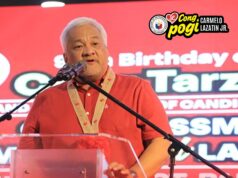This, after the Coach got a negative answer from the UP-NCTS “experts” to his question if the expansion of the Clark International Airport – to start this year with the P1.2-billion for a new terminal – was factored in their study.
A basic question which non-answer now belied the expertise of those experts, doubted the intent, and negated whatever the recommendations rising out of their most obviously incomprehensive, if not definitively flawed, study.
How, indeed, can any traffic study on Clark assume any viability, much less validity, without factoring the 10 million annual passengers expected to start passing through the airport terminal in three years’ time!
The study that was precisely – if belatedly – commissioned by the Clark Development Corp. to determine the impact Capilion Corp.’s Clark Green Frontier project would have on traffic, located as it is right at the very entrance of the Clark Freeport which likewise serves as the main entry too to the Clark airport.
“Looks good on paper, but in reality it’s not really good,” rightly dismissed Guiao.
An even more immediate, and equally telling, blow on the feasibility of the UP-NCTS study was delivered by City Councilor Amos Rivera.
In a meeting on Capilion last year with CDC President-CEO Arthur P. Tugade where Guiao was also present, Rivera asked how many parking slots would be available at the Capilion site.
Tugade replied 1,200.
So, how many will work there, Rivera asked.
Tugade answered 25,000.
“Only ten percent of those workers owning vehicles will be more than twice the capacity of Capilion’s parking slots,” said Rivera. “Workers pa lang yan, e yun pang mallgoers?” It is to be remembered that Capilion will also engage in commercial retail aside from BPO.
Tugade did not answer. A stinking, albeit golden, silence there, if we may say.
The fact that the UP-NCST study was commissioned only after opposition to the Capilion project was raised – with vehemence by the Angeles City Council, with denunciation by the Pinoy Gumising Ka Movement – already conjured malice as to its intent, if not maleficence.
Thus, Rivera – himself having had traffic studies at UP – bewailing the study as being “after the fact, a reverse of the usual process in building and construction.” “You make the traffic impact study before designating the site, to really gauge the effect on time and motion around the area,” so we quoted Rivera in a story here. “As it is now, it would look like the study is being customized to fit and rationalize the Capilion plans and show mere compliance, not to really assess the impact.”
Which lends credence to claims – principally from the PGKM – that the study is being “doctored” to suit the interests of CDC and Capilion, especially as, despite demands from the stakeholders, the study has not been made public eight months since the CDC promised to do so.
Myopic goes Casanova too
And then there’s Atty. Arnel Paciano Casanova, president-CEO of the Bases Conversion and Development Authority, calling for the inclusion of the Metro Manila’s decongestion as “one major political discourse leading up to next year’s presidential election.”
“The respective platforms for next year’s elections will surely point to improving the lives of Filipinos. But if we truly wish to achieve quality of life, let us work toward easing the congestion in Metro Manila.” So was Casanova quoted as saying, and offering the 9,450-hectare master-planned Clark Green City as ready response.
“Our future national leaders need to initiate efforts to arrest urban decay, to resolve a host of perennial traffic and transportation challenges, and to develop another metropolis which is sustainable and disaster-resilient in the face of the global threat of climate change,” added Casanova, further citing how the Clark Green City can accommodate a projected population of 1.2 million, combining new and existing settlers as well as resettled residents.
“We look forward to the Green City as the focal point in plans to ease the congestion in the metropolis. This will be the catalyst for economic growth of surrounding localities leading to an enhanced equitable distribution of development across the country,” cackled Casanova, crowing how the Clark Green City is expected to generate some 800,000 new jobs.
Long in words, short in sight too is Casanova. Sans any ingress-egress to the Clark Green City other than through the Clark Freeport, Casanova is either playing stupidly blind, if not being plainly stupid, in missing to address the looming traffic gridlocks at Clark’s gates with the Capilion project. Given the 1.2 million population, 800,000 workers projected at the Clark Green City.
You call for the decongestion of Metro Manila, you offer Clark as a most viable alternative, yet you accept, if not actively join in, the congestion of the way to Clark.
Aye, it may not be simple myopia but advanced dementia obtaining there.




